A year ago today I last set foot on Petermann’s floating ice shelf. The 28th of August 2016 was a drizzly, cloudy day with water running over the surface of the glacier in small streams emptying into larger streams to form small rivers that merged into larger channels carved into the ice. Two years ago Keith Nichols and I set-up a weather station atop the glacier. Many friends helped. We connected copper wires, ocean sensors, and a surface station to collect data from sensors 100-m below the ice in 800-m deep water. The small 2015 project of opportunity keeps giving us hourly ocean data. I am still stunned by our luck and technology.
- Petermann Glacier Ocean Weather station on 27 August 2015 after it was established the week prior during the US-Sweden expedition to Petermann Fjord.
- Central channel at the end of the melt season in August 2015. Shadow of photographer for scale.
- View to the north-east across Petermann Gletscher from helicopter in August 2015. The growing crack is barely visible emanating from the shear zone near the 1000-m high cliff.
My Petermann story started in 2010 when a first Manhattan-sized ice cube broke off the glacier. Two days after a University of Delaware press release, the US Congress asked me to appear before one of its inquiring committees. I humbly acknowledged how little I knew then, but everyone else knew even less. In 2012 another Manhattan-sized glacier piece broke off. While satellite a image shows what happens, only hard ocean data and modeling explains why it happens. Two research proposals were rejected, sadly, to probe ocean physics with carefully designed experiments, but in 2016 Alan Mix invited me to an expedition to Petermann aboard the Swedish icebreaker Oden. I gladly accepted, but I wanted to contribute something. That “something” became the Petermann Glacier Ocean Weather Observatory.
- The Petermann data machine with batteries (yellow box), solar panels, electronics (white box), antenna, wind vane, and cables to ocean sensors on ground as last seen Aug.-2016.
- Keith Nichols among the rubble of science gear during our refurbishment of Petermann Glacier Ocean Weather and Radar stations on near midnight on 27/28 August 2016.
- Refurbished Petermann Glacier Ocean Weather station on 28. August 2016 with Greenland Air helicopter and British Antarctic radar station in the background.
Alan needed holes drilled through the 100-m to 400-m thick glacier. Actually, he needed mud from 800 meters below the glacier. Keith Nichols of the British Antarctic Survey drilled those holes for Alan and collected the mud. My plan was to recycle the hole, that is, we dropped kevlar line, copper wire, and ocean sensors into the ocean and connected all to a weather station. David Huntley and I designed the system that included an Iridium satellite phone. Iridium phone calls ceased in February 2016, but a “service call,” that is, a helicopter site visit fixed the station. Chris Mooney and Whitney Shefte told the story for the Washington Post on 30 December 2016.
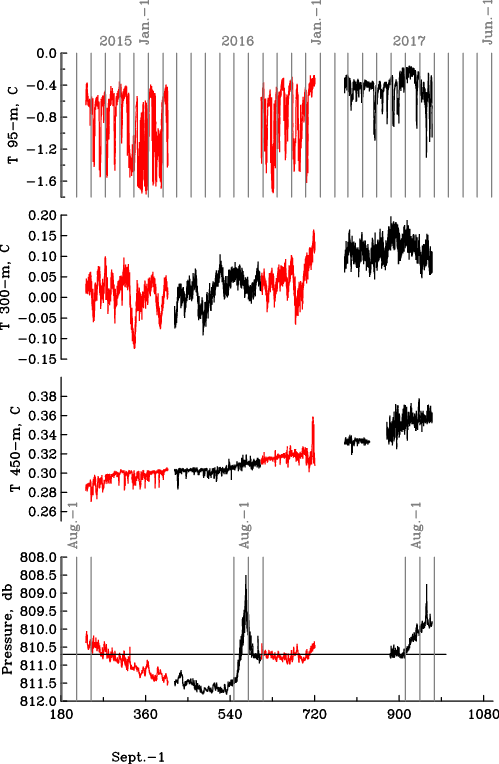
Ocean temperature at 95-m, 300-m, and 450-m below the sea surface as well as pressure at the bottom sensor near 810-m depth (~810 dbar pressure) updated through 27 August 2017.
The graph shows the entire 2-year long data record. Each gray vertical bar indicates a month between July 2015 and December 2017. The top record shows ocean temperatures just below the floating glacier ice. It was a surprise to see the data change from -0.3 Celsius to -1.6 degrees Celsius. The latter is close to the freezing point of salt water. Hence I interpret low-temperature events as meltwater pulse that swoosh past our sensor.
At 300-m we find a smaller range of temperatures near +0.1 degrees Celsius. Note the steady increase of temperature. Fluctuations are similar, but their absolute values increase with time. The linear warming trend becomes clear at 450-m depth, because the fluctuations diminish, but the warming does not. Temperatures at all depths increased over the entire two years of hourly observations.
The pressure record of the bottom-most sensor on the kevlar line perplexes me: During the first year the sensor slides into deeper water, because the kevlar stretches as all lines do when weighted down. In July 2016 the sensor sharply rises by almost 3 meters from 810.5 to 808.5 dbar to just as rapidly drop again to the 810.5 dbar value. The same feature occurs in the summer of 2017 also. It relates to the summer melt season, but how? I do not know.
The 2-year record is not perfect as the many gaps indicate. These result from electronic and mechanical failures that, I feel, are caused by long and harsh winters when temperatures dropped below -40 degrees Celsius or Fahrenheit. These cold temperatures challenge the best batteries during the 4-5 months of total darkness. On 20. December 2016 our batteries ran out and shut down the station. The sun revived our data gathering when the solar panels recharged batteries in March 2017.
The glacier also melts about 1-2 meters at the surface each summer. This surface melt tilted and almost crashed the station that we repaired last year today. In 2015 we had 2-m of pipe to fix into the glacier ice. In 2016 we replaced this with a 4-m pole that should survive two year’s of surface melt, I hope.
There are many, many people who all contributed in ways both small and large. It takes a village to raise a station on Greenland:
- Chief Scientist Alan Mix briefing the science party aboard I/B Oden in July 2015 during transit to Petermann Fjord.
- PhD student Peter Washam programming ocean sensors at the University of Delaware in February 2015.
- David Huntley testing components at the University of Delaware in February 2015.
- United States Air Force C-130 flying us from Schenactady, New York to Thule, Greenland in July 2015.
- Keith Nichols (right) with helicopter pilot Johan Baalack on 10 Aug. 2015 after a test deployment of the weather station on Petermann Glacier.
- Alan Mix and Kelly Hogan with sediment cores recovered from ocean sediments below Petermann Glacier on 9. August 2015.

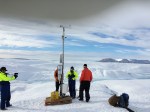
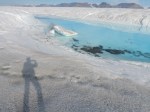
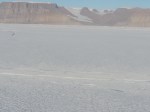








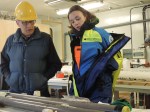

Just trying to think out of the box to come up with hypotheses for the pressure record:
– what is known about the topography of the seabed and what kind of vertical distance would be associated with the pressure difference that was recorded. Could it just be boulders or other seabed features the sensor is dragged over
– what is the drag on the line, if there is a strong current could the sensor potentially be lifted from the bottom. How strong would such a current need to be, is there any mechanism that could explain such a current and are the timescales plausible
– you mentioned meltwater pulses, if a significant portion of the water column is temporarily replaced by less dense fresh water could that register on the sensor as drop in pressure and could it reach the observed magnitude
Ben:
The pressure measurements are from an ocean sensor near the bottom of the kevlar line. It is well above the ocean floor and is free to “swing” in the water like an 800-m long pendulum. Currents at this depths are very weak and probably relate to ocean tides. These deep waters behave differently than the more energetic “density-driven” flows within about 30-50 m off the ice shelf.
We have 2 sensors (I only show data from one) within this 30-m ocean layer under the ice shelf that show meltwater pulses roughly every two weeks (spring-neap tides?). You are right, that much of the circulation is driven by ocean density differences, but these will NOT register as the 2-m pressure changes that we see each summer. I suspect, that is, I do not know, these relate to (a) large surface melting or (b) mechanical deformation such as stretching. Both surface melt and stretching would thin the floating glacier which, if it is in hydrostatic equilibrium, would rise a little. Still, the upward lifting of my mooring line is much larger than a response to surface thinning would suggest. Hence, my bet is that mechanical stretching or compression of the ice during summer is a likely culprit.
Andreas thank you for your in depth response.
I am a layman in this field and as green as they come but couldn’t curb my curiosity. Thanks for taking time to explain it to me.
I do not understand though how mechanical stretching would raise the ancorpoint of the line. Trying to picture two ice cubes in water one thinner than the other. If they are of same density the ratio of the part above and the part below the water should be the same for both. So the thicker one would stick out more above the water in absolute height, Maybe the principle does not apply to a large and complex system like the one you are studying. But if i try to understand it this way i arrive at the opposite conclusion namely that thinning the ice by stretching would lower the ancorpoint.
Surface melt is different because if i understood correctly the ancorpoint is stitting on a pole that does not go down with the surface of the ice as it melts and restoring the equilibrium will move it up.
Ben:
Your thinking is correct and your analogy of two ice cubes in an infinitely large ocean is a good one. We got three different scenarios, stretching, melting at the surface, and melting at the bottom of the ice. As the glaciers is stretched and becomes thinner, the bottom end of my 800-m line (where I measure the pressure) is lowered downward and pressure increases. If we melt the glacier (ice cube) at the surface, it becomes thinner, but to maintain the ratio of 6 parts below water and 1 part above water, say, the removal of surface mass raises the ice cube upward which also raises the line fixed to the ice and thus pressure at the bottom end of my line decreases. If we melt ice from the bottom, mass is removed below the water surface and to maintain the 6:1 ratio now requires that the ice cube sinks a little deeper into the water which increases the pressure at the end of my line. Recall that the line is frozen in 100-m of ice, so the rope is always fixed to the ice.
Again, good thinking. May the physics be with you, always 😉
Andreas, once again, thanks for keeping us informed of progress, very much appreciated. However, I remain convinced that what you are observing, when you observe pressure changes, is the result of what will, eventually, be found to be a massive flush of melt water from melting surface ice, but from the top of the Greenland Ice Shelf, running out under the centre of the floating ice shelf with the flow causing the end of the line to be lifted as the flow increases. Perhaps one way to show this will be to place two more sensors, spaced out either side of the centre line. Another way would be to add a means to measure flow rate, and direction at the same point as you currently measure pressure. Yes, too easy to suggest when I do not possess the means to help gain a better understanding. Just a thought.
Chris.
Thanks again.
Well the physics tell me the surface melt effect would be damped by roughly the 6:1 ratio. So like you mentioned surface melt cannot be the (only) explanation for the pressure record based on that reason alone. Because you would need a surface melt that far exceeds the observed melt. But more importantly you would need another mechanism to bring the sensor back down.
But thinking about stretching I got thinking about the flow of the ice. If the flow stalled in the downstream part (or the upstream part speeds up), the ice could get pressurized and lifted up (like mountains are by plate tectonics). And when the flow is restored it could come down again.
Do you have data on the horizontal movement of (the different parts of) the glacier?
Yes we do, and I should write another blog post about it. The glacier at our station speeds up by 20% in summer when the melt rate is high. It rapidly decelerates to again reach its regular speed in Sept.
Could the pressure fluctuation be related to meltwater loading and unloading the shelf ?
Also for those having difficulty logging into the arctic sea ice forum, please see this thread:
https://forum.arctic-sea-ice.net/index.php/topic,2155.0.html
sidd
Hi,
Here is some data from Wandel Hav, two discussion papers at ocean-sci-discuss
https://www.ocean-sci-discuss.net/os-2017-28/
https://www.ocean-sci-discuss.net/os-2017-60/
You probably saw these already, but i thought i would post in case otherwise.
sidd
Pingback: What’s happened at Petermann Gletscher since the Industrial Revolution 150 years ago? | Icy Seas